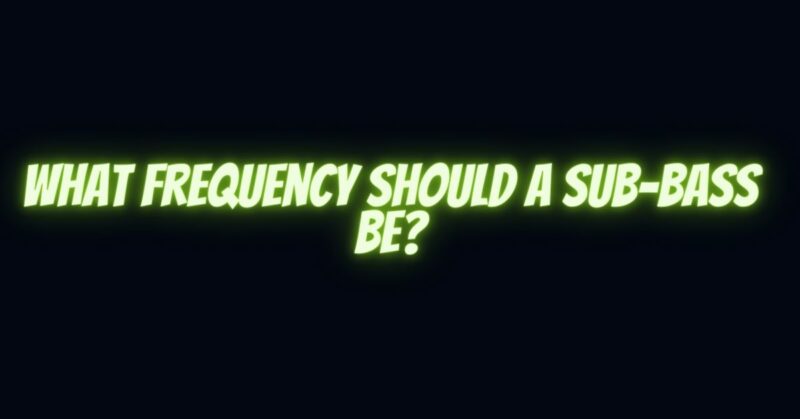Sub-bass frequencies are the foundation of many music genres, providing depth, power, and impact to a track. Musicians, producers, and sound engineers spend considerable time crafting sub-bass sounds that resonate with listeners. However, determining the ideal frequency for a sub-bass is a critical aspect of this process. In this article, we will explore the factors that influence the choice of sub-bass frequencies and help you understand what frequency a sub-bass should be for your specific musical needs.
Understanding Sub-Bass Frequencies
Sub-bass frequencies refer to the lowest range of audible sound frequencies, typically below 60 Hz. They are responsible for producing the deep, rumbling, and sometimes physically felt sensations in music. Sub-bass frequencies play a crucial role in genres such as electronic dance music (EDM), hip-hop, dubstep, and cinematic soundtracks.
Factors Influencing Sub-Bass Frequency Choice
Several factors influence the choice of sub-bass frequencies in music production:
- Musical Genre: The genre of music you are producing has a significant impact on the choice of sub-bass frequency. For example, EDM tracks often feature sub-bass frequencies around 30-60 Hz, while hip-hop and dubstep may go even lower, down to 20-30 Hz. Cinematic soundtracks may vary widely depending on the mood and context of the scene.
- Instrumentation: The choice of instruments or synthesizers used to create sub-bass sounds can influence the frequency range. Synthesizers and electronic bass instruments often have more flexibility in shaping sub-bass frequencies compared to acoustic instruments.
- Arrangement and Composition: The arrangement of musical elements in a track can dictate where sub-bass frequencies should sit. A sparse arrangement may allow for a more prominent sub-bass presence, while a dense mix might require more subtle sub-bass tones to avoid muddiness.
- Room Acoustics: The acoustics of the listening environment, including the room size and speaker system, can affect the perception of sub-bass frequencies. Smaller rooms may have resonant frequencies that amplify or attenuate certain sub-bass frequencies.
- Listener Preference: Ultimately, the choice of sub-bass frequency should align with the preferences of the target audience. Some listeners may prefer tracks with more pronounced sub-bass, while others might prefer a cleaner, more balanced sound.
Common Sub-Bass Frequencies in Different Genres
While there is no one-size-fits-all answer to the question of what frequency a sub-bass should be, here are some common sub-bass frequency ranges found in different musical genres:
- EDM and House: Sub-bass frequencies in EDM and house music often range from 30 Hz to 60 Hz. These frequencies provide the driving, pulsating rhythm that defines these genres.
- Hip-Hop and Rap: Hip-hop and rap tracks may feature sub-bass frequencies as low as 20 Hz to 30 Hz. The emphasis on deep, booming bass is a hallmark of these genres.
- Dubstep: Dubstep takes sub-bass to even lower depths, with frequencies ranging from 20 Hz to 40 Hz or lower. This genre is known for its intense and aggressive basslines.
- Cinematic and Soundtracks: Sub-bass frequencies in cinematic and soundtrack music vary widely depending on the context. They can range from 20 Hz to 60 Hz or higher, depending on the desired emotional impact of the music.
Fine-Tuning Sub-Bass Frequencies
To determine the ideal sub-bass frequency for your music, consider the following steps:
- Listen and Experiment: Listen to reference tracks in your chosen genre to get a sense of the sub-bass frequencies commonly used. Experiment with different frequencies to find what suits your track best.
- Monitor with Quality Speakers: Use high-quality studio monitors or headphones to accurately assess the sub-bass frequencies in your mix. Poor monitoring can lead to inaccurate judgments.
- Room Treatment: If possible, treat your listening environment to minimize room acoustics’ influence on sub-bass frequencies.
- Get Feedback: Seek feedback from other producers, musicians, or experienced engineers to ensure your sub-bass frequencies align with industry standards and listener expectations.
Determining the right sub-bass frequency for your music is a creative and technical process that depends on various factors, including genre, instrumentation, arrangement, and audience preference. While there are common sub-bass frequency ranges associated with different musical styles, there is no strict rule. Ultimately, the choice of sub-bass frequency should serve the musical vision of your composition, enhancing its emotional impact and overall sonic quality.


